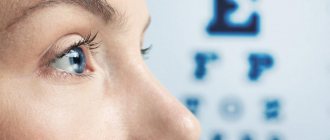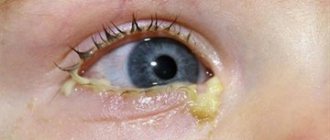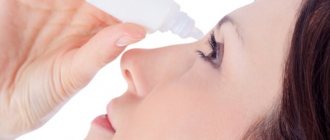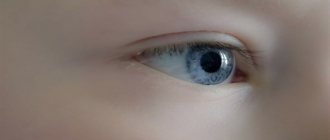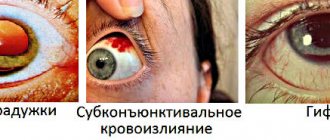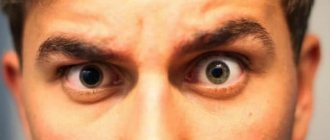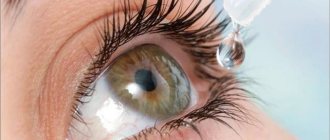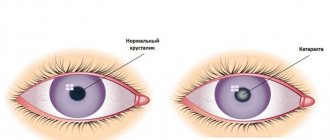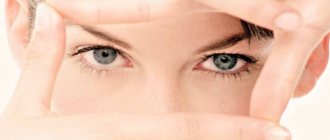Children suffer from ophthalmological diseases more often than adults, since a child’s curiosity knows no bounds.
The child perceives the world around him not only through vision, but also through tactile sensations. The baby needs to feel the object.
Dirty hands are the main source of infection. Rubbing the eyes with unwashed hands leads to the development of bacterial and viral infections. Any diseases need to be eliminated at the initial stage of development; eye drops will help with this.
The type of medication prescribed (anti-inflammatory, moisturizing, antibacterial, antihistamine) depends on the cause of the discomfort.
Antimicrobial eye drops for children
Antiseptics, antibiotics, sulfonamides and antibacterial chemotherapy drugs in eye drops for children.
| Permitted age | Active substance | Dosage | Instructions for use |
| from 0 years | Azithromycin 1.5% | 1 drop every 12 hours 3 days | Azidrop |
| ‡ Ofloxacin 0.3% VED | 1 drop every 6-12 hours for no longer than 14 days | Floxal from 0 years, Ofloxacin-SOLOpharm from 1 year, Uniflox from 1 year, Dancil from 1 year | |
| Picloxidine 0.05% | 1 drop every 4-12 hours for 10 days | Bactavit, Vitabakt | |
| ‡%Sulfacetamide 20% | 1 drop every 2-3 hours 7-10 days | Sulfacyl sodium (PFK Obnovlenye) from 0 years, Sulfacyl sodium (RUE "Belmedpreparaty") from 0 years, Sulfacyl sodium (JSC Sintez) from 0 years, Sulfacyl sodium (VIPS-MED) from 0 years, Sulfacyl sodium -DIA from 2 months, Albucid from 2 months, Sulfacyl sodium (Slavyanskaya Pharmacy) from 2 months, Sulfacyl sodium (YuzhPharm) from 2 months, Sulfacyl sodium - SOLOpharm from 2 months | |
| Fusidic acid 1% | 1 drop every 12 hours 7 days | Fucithalmic | |
| ‡ %Ciprofloxacin 0.3% VED | 1-2 drops every 6 hours for no longer than 21 days; for severe inflammation according to the scheme described in the instructions | Ciprofloxacin-SOLOpharm from 0 years, Rocip from 0 years, Ciprofloxacin-Optik from 0 years, Ciprofloxacin (JSC PFK Obnovlenye) from 1 year, Ciprolet from 1 year, Cipromed from 1 year, Ciprofloxacin (K.O. Rompharm) from 1 year, Betaciprol from 1 year, Ciprofloxacin-AKOS from 18 years | |
| from 1 month | Chloramphenicol 0.25% | 1-2 drops every 1-4 hours 7-10 days | Levomycetin (PFK Obnovleniya), Levomycetin (Tathimfarmpreparaty), Levomycetin-DIA, Levomycetin (Slavic Pharmacy), Levomycetin-AKOS, Levomycetin (LEKKO) |
| from 2 months | ‡ Tobramycin 0.3% VED | 1 drop every 1-4 hours | Alemtob from 2 months, Tobramycin from 2 months, Tobriss from 2 months, Tobrosopt from 2 months, Tobrex 2X from 1 year, Tobrex from 18 years, Tobropt from 18 years |
| from 1 year | Gatifloxacin 0.3% | 1 drop every 2 hours for 2 days (up to 8 times a day), then every 6-8-12 hours for 5 days | Zimar |
| Gentamicin 0.3% VED | 1 drop every 1-4 hours for no more than 14 days | Gentamicin-Ferein, Gentamicin (FSUE "MOSCOW ENDOCRINE PLANT"), Gentamicin (JSC Warsaw Pharmaceutical Plant Polfa) | |
| Levofloxacin 0.5% VED | 1-2 drops every 2 hours (up to 8 times a day) for the first 2 days, then every 6 hours for 3 days | Levofloxacin-Optik, Levofloxacin-SOLOpharm, Levofloxacin (FSUE "MOSCOW ENDOCRINE PLANT"), L-OPTIC ROMFARM, Levofloxacin (RUE "Belmedpreparaty"), Signicef, Oftaquix | |
| Moxifloxacin 0.5% VED | 1 drop every 8 hours 7-8 days | Floxepol, Bivoksa VM, Moxifloxacin-Optic, Maxiflox, Moxifur, Vigamox | |
| Norfloxacin 0.3% | 1 drop every 6 hours 7 days | Normax | |
| from 3 years | Netilmicin 0.3% | 1-2 drops every 8 hours | Nettatsin |
The main causes of red eyes in a child
Redness of the eyes in a child (the causes can be internal, and not just external; in particular, redness of the eyes is a consequence of certain pathological processes in the body) can be caused by the following external factors:
Mechanical damage, injuries
Contact with the mucous membrane of the eye of a foreign body (mote, fallen eyelash), which irritates the conjunctiva, causing redness. If a child falls, the eye area may be bruised. The consequence will be swelling of the eyelids and hemorrhage into the sclera.
Accidental contact with the mucous membrane of the eyes of alkaline and acidic solutions can cause a chemical burn. In this case, rinse your eyes thoroughly with running water. If the burning, redness and swelling do not go away within an hour, you should urgently seek medical help.
Irritation of the mucous membranes of the eyes due to dry air, smoke
During the heating season, in the absence of an ozonizer, the air in the apartment loses humidity, causing dry eye syndrome in the inhabitants of the home, accompanied by pain and redness of the sclera. Being in a smoky room has a similar effect on a child's eyes . With passive smoking, the baby’s vision, along with other important organs, also suffers.
Violation of the daily routine
A full night's sleep gives the body the opportunity to rest and recover after an active day. When the eyelids are closed and relaxed, tear fluid is produced, which prevents dryness of the conjunctiva.
Influence of computer, TV, smartphone
When a child spends a long time looking at a computer monitor or TV, the child strains his eyesight and blinks less often, which causes the outer layer of the eyeball to dry out. Prolonged flickering of the screen irritates the eyes, causing watery eyes and redness.
Passion for social networks and games on a smartphone or tablet increases the load on the eye muscles and increases eye pressure. As a result, the burst capillaries of the choroid stain the sclera. If a child is sitting at a computer or gadget, it is necessary to ensure a distance to the eyes of 60-70 cm.
Corrective glasses
Glasses with errors in diopters and interpupillary distance can worsen vision. The first signs will be fatigue and red eyes. In this case, you must stop wearing glasses and undergo the examination again.
Bad light
The cause of red eyes in a child can be drawing and reading in low light.
Computers and other electronic devices should also be used in well-lit areas.
Water
Swimming in open water can cause pathogenic bacteria to come into contact with the eyes, causing irritation and redness of the conjunctiva. If the immune system fails, serious illnesses may develop.
The water in swimming pools is purified of bacteria using chlorination. Chlorine is a strong allergen; getting pool water into the eyes causes redness of the eyelids and sclera.
Anti-inflammatory eye drops for children
Corticosteroids (hormones) and nonsteroidal anti-inflammatory drugs (NSAIDs) in eye drops are generally contraindicated in children. Listed below are drugs for which children's age is not indicated as a contraindication in the instructions; use in children is permitted with caution or if the expected benefit outweighs the potential risk.
Nonsteroidal anti-inflammatory drugs
| Permitted age | Active substance | Dosage | Instructions for use |
| from 0 years | Diclofenac 0.1% VED | 1 drop every 6-8 hours 7-14 days | Diklo-F, Diclofenac (K.O.Rompharm Company S.R.L.), Diclofenac (FSUE MOSCOW ENDOCRINE PLANT), Diclofenaclong, Diclofenac (JSC Sintez), Diclofenac-SOLOpharm |
Corticosteroids
| Permitted age | Active substance | Dosage | Instructions for use |
| from 6 years | ‡ Dexamethasone 0.1% | 1 drop every 8-12 hours 7-10 days | Dexamethasone-Betalek (discontinued?) from 0 years, Dexamethasone (K.O.Rompharm Company S.R.L.) from 6 years |
Corticosteroids in combination with antimicrobials
| Permitted age | Active substance | Dosage | Instructions for use |
| from 0 years | ‡ Dexamethasone 0.1% + Tobramycin 0.3% | 1-2 drops every 4-6 hours | Tobrazon from 0 years, Tobradex from 2 years, DexaTobropt from 12 years |
| Dexamethasone 0.1% + Neomycin 3500 IU + Polymyxin B 6000 IU | 1-2 drops every 4-24 hours | Maxitrol | |
| from 1 year | Dexamethasone 0.05% + Gramicidin 0.005% + Framycetin 0.5% | 1-2 drops every 4 hours for no more than 7 days | Sofradex |
| from 8 years | Betamethasone 0.1316% + Gentamicin 0.3% | 1-2 drops every 6-8 hours for no more than 14 days | Gentazon |
Redness of the eyes due to illness
Bacterial, viral infections and allergic reactions cause eye irritation and inflammation. Redness of the whites and eyelids occurs with various diseases of the organs of vision and some chronic internal diseases. In children, the most common causes of red eyes are:
Allergy
Contact with the allergen primarily causes itching and irritation of the eyes. Dust, pollen, fluff, and some food products cause allergic reactions. In addition to eye discomfort, allergy symptoms include skin rashes, runny nose, nausea, and headache.
First of all, you need to stop contact with the allergen and give the child an antihistamine.
Conjunctivitis
Redness of the eyes in a child (the causes may be viral or bacterial) is often caused by inflammation of the conjunctiva.
With viral conjunctivitis, inflammation of the eyes is accompanied by a runny nose and increased body temperature. A bacterial infection causes the formation of copious white or greenish purulent discharge.
Eye pressure
Red eyes accompanied by excessive tearing and dilated pupils may indicate increased eye pressure. In this case, the child reacts painfully to bright light and complains of a headache in the forehead and temples.
Eye pressure may be intermittent due to visual fatigue. Rest and exercise restrictions eliminate the problem. The danger of long-term hypertension is that it may be a sign of the development of glaucoma.
Endocrine ophthalmopathy
The cause of dilatation of the vessels of the eyeball may be endocrine diseases.
When hormonal imbalances occur due to pathologies of the thyroid gland, ophthalmopathy of autoimmune origin develops. The child requires comprehensive examination and treatment. Self-medication is unacceptable.
Cold
With colds, the mucous membrane of the eye turns red due to pathogenic bacteria entering the mucosa. The process is often accompanied by lacrimation, itching, burning, and photophobia.
Antiallergic eye drops for children
Mast cell membrane stabilizers and H1-antihistamines in eye drops for allergies for children.
| Permitted age | Active substance | Dosage | Instructions for use |
| from 0 years | ‡ Cromoglicic acid 2% | 1 drop every 6-12 hours 7-28 days | Kromoglin from 0 years, High-Krom from 0 years, Cromohexal from 2 years, ALLERGO-KOMOD from 4 years, Dipolkrom from 4 years, Krom-allerg from 4 years, Cromicil-SOLOpharm from 4 years, Lecrolin from 4 years |
| from 3 years | Olopatadine 0.1%; 0.2% | 0.1% 1 drop every 12 hours for no more than 120 days 0.2% 1 drop every 24 hours for no more than 120 days | Olopathallerg 0.1%, Oloridine 0.1%, Oloftadine IVF 0.1%, Opatanol 0.1%, Visallergol 0.2% |
| from 4 years | Azelastine 0.05% | 1 drop every 6-12 hours for no more than 42 days | Allergodil |
| from 12 years old | Levocabastine 0.05% | 1 drop every 6-12 hours | Reactin, Visin Alergy |
| Epinastine 0.05% | 1 drop every 12 hours for no more than 56 days | Epinepta |
If accompanied by swelling
When redness of the eyes is accompanied by swelling of the eyelids, this may indicate the development of a disease common in children - blepharitis.
Inflammation is caused by Staphylococcus aureus, which children spread to the mucous membrane by rubbing the eye with unwashed hands. The danger lies in the transition of the disease to a chronic form, in which ulcers on the eyelids appear at the slightest hypothermia and a mild cold.
A dangerous signal is swelling of the eyelids during an allergic reaction. With prolonged contact with the allergen, angioedema may develop. If swelling of the eyelids is accompanied by itching, sneezing, or difficulty breathing, you should urgently call an ambulance.
Moisturizing eye drops for children
Artificial tears and other indifferent drugs. Some moisturizing drops should be used with caution in children, as there is no data on their effectiveness and safety. The drops can be replaced with a physiological 0.9% NaCl solution (by the way, it is produced in plastic ampoules). You may have to drip more often, but it is definitely safe.
| Permitted age | Active substance | Dosage | Instructions for use |
| from 0 years | Hypromellose 0.5% VED | 1-2 drops every 3-6 hours 14-21 days | Artificial tear, Hypromelose, Hypromelose-P |
| ‡ Hypromellose 0.3% + Dextran-70 0.1% | 1-2 drops as needed | Natural tear, Slezin from 18 years old | |
| Polyvinyl alcohol 1.4% + povidone 0.6% | 1-2 drops every 6-8 hours | Oftolik, Oftolik BK |
Eye drops to dilate the pupil for children
Mydriatic and cycloplegic drugs.
| Permitted age | Active substance | Dosage | Instructions for use |
| from 0 years | Tropicamide 0.5% VED | 1 drop 2 times with an interval of 5 minutes | Tropicamide (Warsaw Pharmaceutical Plant Polfa), Tropicamide (Promed Exports Pvt. Ltd.), Tropicamide (K.O.Rompharm Company S.R.L.), Tropicamide-SOLOpharm (Grotex LLC), Tropicamide (FSUE MOSCOW ENDOCRINE PLANT "), Midriacil |
| Phenylephrine 2.5% | 1 drop before the procedure | Irifrin | |
| ‡ Cyclopentolate 1% | 1 drop before the procedure | Cyclomed, Mecitoline from 3 years, Cycloptic from 3 years | |
| from 6 years | Tropicamide 1% VED | 1 drop 2 times with an interval of 5 minutes | Tropicamide (Warsaw Pharmaceutical Plant Polfa), Tropicamide (Promed Exports Pvt. Ltd.), Tropicamide (K.O.Rompharm Company S.R.L.), Tropicamide-SOLOpharm (Grotex LLC), Tropicamide (FSUE MOSCOW ENDOCRINE PLANT "), Midriacil, Tropicam |
| from 7 years | Atropine 1% VED | 1-2 drops up to 3 times with an interval of 5-6 hours | Atropine (FSUE "MOSCOW ENDOCRINE PLANT") |
| from 12 years old | Tropicamide 0.8% + Phenylephrine 5% | 1-2 drops 15-20 minutes before the procedure | Midrimax |
| Phenylephrine 5% | 1 drop before the procedure | Neosynephrine-pos |
If only one eye
If only one eye of a child is red, the reason may be that a foreign object has come into contact with the mucous membrane.
Bacterial conjunctivitis begins with redness of the corner of one eye and swelling of the eyelid. Initially, the infection affects one eye, and after a few hours it spreads to the other.
Inflammation of the vascular network of the eye indicates the beginning of the development of uveitis. Progression of the disease can lead to glaucoma, which causes decreased vision up to blindness. With post-traumatic uveitis, one eye is affected.



